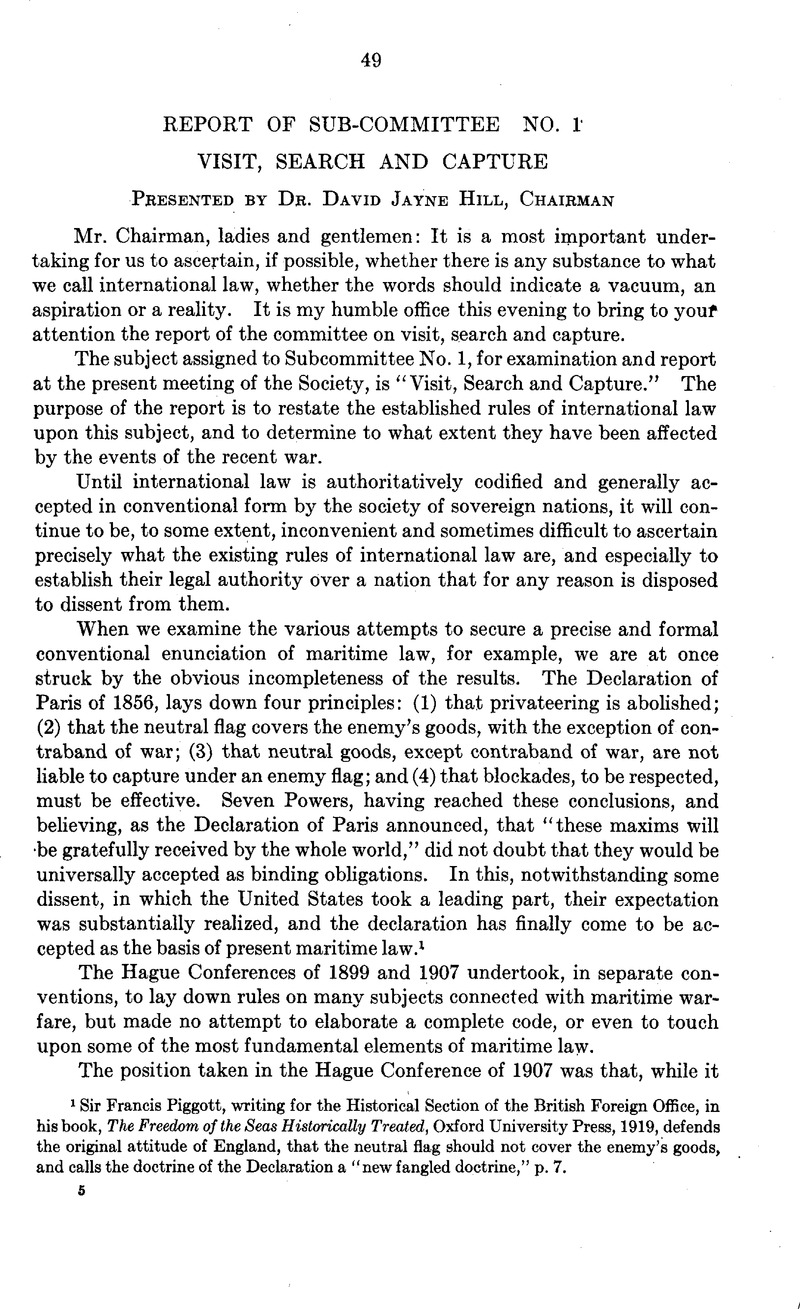No CrossRef data available.
Article contents
Visit, Search and Capture. Report of Subcommittee No. 1
Published online by Cambridge University Press: 27 February 2017
Abstract

- Type
- Third Session
- Information
- Copyright
- Copyright © American Society of International Law 1922
References
1 Sir Francis Piggott, writing for the Historical Section of the British Foreign Office, in his book, The Freedom of the Seas Historically Treated, Oxford University Press, 1919, defends the original attitude of England, that the neutral flag should not cover the enemy's goods, and calls the doctrine of the Declaration a “new fangled doctrine,” p. 7.
2 The Hague Conventions and Declarations of 1899 and 1907, Scott's edition, 1915, p. 182.
3 The Declaration of London, February 26, 1909, Scott's edition, 1919.
4 See Resolutions of the Institute of International Law Dealing with the Law of Nations, Oxford University Press, 1916, pp. 174, 201.
5 At the First and the Second Hague Conferences the American delegates were instructed to advocate the immunity from seizure of enemy private property at sea. Instructions to the Americam Delegates, Oxford University Press, 1916, pp. 9 and 81. See also the discourse of the Honorable Andrew D. White, Conference Internationale de la Paix, La Haye 18 mai-29 juillet 1899, pp. 31, 33; and that of the Honorable Joseph Choate, Deuxieme Conference Internationale de la Paix, La Haye 15 juin-18 octobre, 1907, Actes et Documents III, pp. 750, 764. Also the Report of M. Fromageot, Scott, The Hague Peace Conferences, Baltimore, 1909, Vol. I, pp. 701, 704. The subject was not brought up for action at the Conference for the Limitation of Armament.
6 The substance of what is generally regarded as the “common law” on this subject is stated in Articles 17,19 of the Treaty of the Pyrenees, between France and Spain, of November 7, 1659, which has served as a model for many treaties between separate nations. See Vast, Les Grands Traites, Vol. I, pp. 102, 103. It is also found in many treaties of the United States.
7 For the German authorities, see Heffter, with Geffcken's notes, Das Europdische Volkerrecht der Gegenwart, Berlin, 1888, pp. 373, 375; Quaritch, Compendium des Europdischen Volkerrechts, Berlin, 1901; Liszt, Das Volkerrecht Septematisch Dargestellt, Berlin, 1906; Ullmann, Volkerrecht, Tubingen, 1908. See also the citations in Scott, A Survey of International Relations between the United States and Germany, New York, 1917, pp. 265, 289.
8 A very full list of Instructions is given by Fauchille, Traite de Droit International Public, Vol. II, pp. 542,544. Also Garner, International Law in the World War, Vol. I, pp. 8, 12.
9 Bowles, The Declaration of Paris, p. 7, cited by Garner, p. 9.
10 Garner, as before, p. 10.
11 For a very interesting note on the right of convoy, see Hershey, The International Law and Diplomacy of the Russo-Japanese War, New York, 1906, pp. 150,151. The exemption of neutral vessels under neutral convoy is stated in most of the instructions of government. See Fauchille, p. 1006. The question was not raised in the Washington Conference.
12 See the article on “Destruction of Neutral Property” by Mr. Quincy Wright in the American Journal of International Law for April, 1917, p. 362, in which it is shown that on the Continent “the primary function of prize courts is considered to be, not the protection of neutrals, but the protection of the government against acts by its naval forces in violation of their orders and instructions.
13 Senate Document No. 125, p. 109.
14 Diplomatic Correspondence, Vol. 10, p. 190.
15 Id., p. 197.
16 Id., p. 198.
17 Declaration of London, p. 81.
18 Senate Document No. 125, p. 109.
19 Senate Document No. 125, p. 110.
20 The Nineteenth Century and After, for March, 1922, pp. 406, 407.




